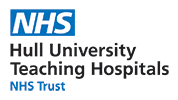- Reference Number: HEY-857/2023
- Departments: Paediatrics
- Last Updated: 2 January 2023
Introduction
This leaflet has been produced to give you general information about your child’s condition. Most of your questions should be answered by this leaflet. It is not intended to replace the discussion between you and your doctor, but may act as a starting point for discussion. If after reading it you have any concerns or require further explanation, please discuss this with a member of the healthcare team caring for your child.
What is bronchiolitis?
Bronchiolitis is an infection of the small airways of the lung. It is a common infection in babies and children under 2 years old. It is caused by a virus, often the respiratory syncytial virus (RSV), which is spread through tiny droplets of liquid from the coughs or sneezes of someone who is infected. RSV causes the airways to become swollen and full of mucus. In adults and older children, RSV is a common cause of colds.
Symptoms of bronchiolitis
The early symptoms of bronchiolitis are similar to those of a common cold, such as a runny nose and cough. Further symptoms then usually develop over the next few days and include a high temperature, a dry and persistent cough, difficulty feeding and rapid or noisy breathing (wheezing).
How is bronchiolitis treated?
Bronchiolitis is caused by a virus and so antibiotics do not help. It is a self-limiting illness, which means it will go away as the immune system clears the virus. There is no medicine which will kill the virus. Many types of treatment have been tried over the years. Unfortunately research has shown that they do not make a difference to the course of the illness. Most affected babies are not seriously ill and will make a full recovery at home. About 3 in 100 babies are admitted to hospital for extra oxygen, help with their breathing or help with feeding.
How long does Bronchiolitis last?
Bronchiolitis more or less follows a typical timeline and your child may get worse before they get better: On days 1, 2 and 3 children suffer from a blocked, snotty nose and cough. The following days, breathing may become more difficult with problems feeding and sometimes apneas (short breath-holding episodes). Generally, from days 6 and 7, children will start improving.
Can you have Bronchiolitis more than once?
It is possible to have bronchiolitis again, but most babies will only have it once. Wheezing and coughing can occur with the next few colds after having bronchiolitis, but are usually mild. If the wheeze or cough keeps happening, speak to your doctor.
What can I do to help my baby?
- Breathing may be easier for your baby if he or she sleeps with the head of the cot slightly raised (raise the mattress slightly by placing a pillow underneath the mattress).
- Make sure your child gets enough fluid. Smaller, more frequent feeds are sometimes best.
- Give children’s paracetamol/ibuprofen to bring down their temperature if required.
- Do not smoke in the house.
Contact your GP if:
- You are worried about your child.
- They are having difficulty breathing.
- Your baby is taking less than half his or her usual feeds over 2 to 3 feeds, or has no wet nappy for 12 hours.
- Your baby has a high temperature.
- Your baby seems very tired or irritable.
Call 999 if:
- Your baby is having a lot of difficulty breathing and is pale or sweaty.
- Your baby’s tongue and lips are turning blue.
- There are long pauses in your baby’s breathing.
How can I prevent bronchiolitis?
- Wash your hands and your child’s hands frequently.
- Wash or wipe toys and surfaces frequently.
- Keep infected children at home until their symptoms have improved.
- Keep newborn babies away from people with colds or flu.
- Children exposed to cigarette smoke at home tend to get a more severe form of bronchiolitis – Do not smoke in the house.
Key points to remember:
- Bronchiolitis gets better in a week to ten days (although the cough may last longer).
- Bronchiolitis is a viral infection, so antibiotics will not help.
- Your child may need to take smaller feeds more often.
- Speak to your doctor if your child has difficulty with breathing or feeding.
Should you require further advice on the issues contained in this leaflet, please do not hesitate to contact the Paediatric Department on telephone no: 01482674465.
General Advice and Consent
Most of your questions should have been answered by this leaflet, but remember that this is only a starting point for discussion with the healthcare team.
Consent to treatment
Before any doctor, nurse or therapist examines or treats your child, they must seek your consent or permission. In order to make a decision, you need to have information from health professionals about the treatment or investigation which is being offered to your child. You should always ask them more questions if you do not understand or if you want more information.
The information you receive should be about your child’s condition, the alternatives available for your child, and whether it carries risks as well as the benefits. What is important is that your consent is genuine or valid. That means:
- you must be able to give your consent
- you must be given enough information to enable you to make a decision
- you must be acting under your own free will and not under the strong influence of another person
Information about your child
We collect and use your child’s information to provide your child with care and treatment. As part of your child’s care, information about your child will be shared between members of a healthcare team, some of whom you may not meet. Your child’s information may also be used to help train staff, to check the quality of our care, to manage and plan the health service, and to help with research. Wherever possible we use anonymous data.
We may pass on relevant information to other health organisations that provide your child with care. All information is treated as strictly confidential and is not given to anyone who does not need it. If you have any concerns please ask your child’s doctor, or the person caring for your child.
Under the General Data Protection Regulation and the Data Protection Act 2018 we are responsible for maintaining the confidentiality of any information we hold about your child. For further information visit the following page: Confidential Information about You.
If you need information about your child’s (or a child you care for) health and wellbeing and their care and treatment in a different format, such as large print, braille or audio, due to disability, impairment or sensory loss, please advise a member of staff and this can be arranged.

